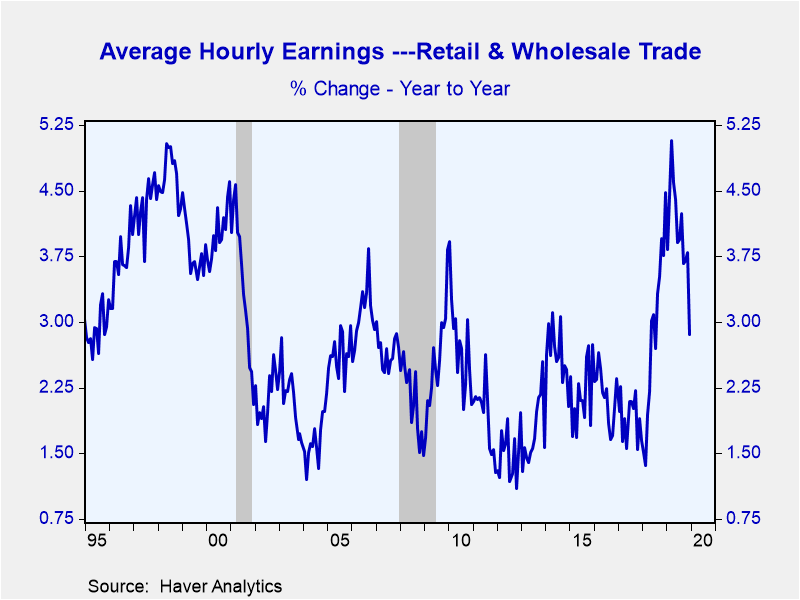 Global| Jan 13 2020
Global| Jan 13 2020December's Slower Wage Growth Reflects Drop in Incentive/Commission Income---Labor Markets Are Still Tight
|in:Viewpoints
Summary
The abrupt drop in average hourly earnings in December to a 3% gain, 50 basis points below the run-rate of the past year, is as much of a surprise as it is a puzzle. How can the wage data show a one-month plunge in earnings growth [...]
 The abrupt drop in average hourly earnings in December to a 3% gain, 50 basis points below the run-rate of the past year, is as much of a surprise as it is a puzzle. How can the wage data show a one-month plunge in earnings growth when the other parts of the labor report showed steady gains in new hiring (+145,000 in December) and no change in the unemployment rate (3.5%)? The answer could be a large drop in incentive or commission income due to soft holiday sales at a number of business establishments in retail and wholesale trade.
The abrupt drop in average hourly earnings in December to a 3% gain, 50 basis points below the run-rate of the past year, is as much of a surprise as it is a puzzle. How can the wage data show a one-month plunge in earnings growth when the other parts of the labor report showed steady gains in new hiring (+145,000 in December) and no change in the unemployment rate (3.5%)? The answer could be a large drop in incentive or commission income due to soft holiday sales at a number of business establishments in retail and wholesale trade.
Earnings in the payroll employment report not only include regular wage and pay increases but also monthly bonuses and commission income tied to workers sales performance. It's the latter component of earnings that might explain the sharp drop-off in the rate of earnings growth.
December's data on wages show an exceptionally large deceleration in the retail and wholesale trade sectors. Wages in the two trade sectors combined posted an annual gain of 2.9%, off sharply from the 4.5% gain recorded one year earlier.
Payrolls of retail and wholesale trade account for nearly 20% of total payroll employment so the 160 basis points drop---from 4.5% to 2.9% in wage growth--- would account for more than the 50 basis points deceleration---from 3.5% to 3.0%---in average hourly earnings.
The sharp slowdown in earnings growth in retail and wholesale trade occurred even though these businesses added 50,000 new workers in December. The addition of new workers suggests that these companies were not looking to cut labor costs in December so that raises the possibility that the reduction is earnings growth came from other parts of labor compensation.
Combined, November retail and wholesale sales were up a mere 2% from year ago levels, roughly half of the 2018 performance. Yet, sales at many of the high-profile retail establishments, such as general merchandise and clothing stores posted a decline of 1% ----well off the 4% gain of one year earlier.
With reduced growth in sales, and declines in some areas, odds are relatively high that incentive or commission-base income dropped sharply in 2019 versus what was paid in 2018. None of this is meant to downplay the importance of commission income, only to point out its “lumpiness” and its sensitivity to sales performances.
Investors should be also mindful that sales are a good proxy for revenue growth ---and the soft sales reports should be seen as a harbinger of weak Q4 profits in a number of businesses as well.
Viewpoint commentaries are the opinions of the author and do not reflect the views of Haver Analytics.Joseph G. Carson
AuthorMore in Author Profile »Joseph G. Carson, Former Director of Global Economic Research, Alliance Bernstein. Joseph G. Carson joined Alliance Bernstein in 2001. He oversaw the Economic Analysis team for Alliance Bernstein Fixed Income and has primary responsibility for the economic and interest-rate analysis of the US. Previously, Carson was chief economist of the Americas for UBS Warburg, where he was primarily responsible for forecasting the US economy and interest rates. From 1996 to 1999, he was chief US economist at Deutsche Bank. While there, Carson was named to the Institutional Investor All-Star Team for Fixed Income and ranked as one of Best Analysts and Economists by The Global Investor Fixed Income Survey. He began his professional career in 1977 as a staff economist for the chief economist’s office in the US Department of Commerce, where he was designated the department’s representative at the Council on Wage and Price Stability during President Carter’s voluntary wage and price guidelines program. In 1979, Carson joined General Motors as an analyst. He held a variety of roles at GM, including chief forecaster for North America and chief analyst in charge of production recommendations for the Truck Group. From 1981 to 1986, Carson served as vice president and senior economist for the Capital Markets Economics Group at Merrill Lynch. In 1986, he joined Chemical Bank; he later became its chief economist. From 1992 to 1996, Carson served as chief economist at Dean Witter, where he sat on the investment-policy and stock-selection committees. He received his BA and MA from Youngstown State University and did his PhD coursework at George Washington University. Honorary Doctorate Degree, Business Administration Youngstown State University 2016. Location: New York.


